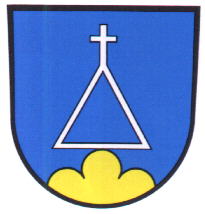Hohensachsen: Difference between revisions
Knorrepoes (talk | contribs) m (Text replacement - "/Arms of " to "/Arms (crest) of ") |
Knorrepoes (talk | contribs) m (Text replacement - "{{media}}" to " {{de1}} {{media1}}") |
||
| Line 25: | Line 25: | ||
The arms are derived from the oldest known seal of the village, dating from 1537. It already showed the triangle with cross above some small mountains. The symbol is the local village sign, the mountains are probably a canting element (Hohen- or high-). The colours are those of the Wittelsbach family, Princes of the Pfalz, to which the village historically belonged. | The arms are derived from the oldest known seal of the village, dating from 1537. It already showed the triangle with cross above some small mountains. The symbol is the local village sign, the mountains are probably a canting element (Hohen- or high-). The colours are those of the Wittelsbach family, Princes of the Pfalz, to which the village historically belonged. | ||
{{ | |||
{{de1}} | |||
{{media1}} | |||
[[Civic Heraldry Literature - Germany|'''Literature''']]: John and Wüst, 1996 | [[Civic Heraldry Literature - Germany|'''Literature''']]: John and Wüst, 1996 | ||
Revision as of 11:45, 26 December 2022
This page is part of the German heraldry portal |
Heraldry of the World |
|
German heraldry:
|
Selected collector's items from Germany:
|
HOHENSACHSEN
State : Baden-Württemberg
District (Kreis) : Rhein-Neckar Kreis (until 1973 Mannheim)
Incorporated into : 1973 Weinheim
| German |
In Blau über goldenem Dreiberg ein an der Spitze in ein Kreuz auslaufendes silbernes Dreieck. |
| English | No blazon/translation known. Please click here to send your (heraldic !) blazon or translation |
Origin/meaning
The arms were granted in 1959 after a proposal from the State archives from 1910.
The arms are derived from the oldest known seal of the village, dating from 1537. It already showed the triangle with cross above some small mountains. The symbol is the local village sign, the mountains are probably a canting element (Hohen- or high-). The colours are those of the Wittelsbach family, Princes of the Pfalz, to which the village historically belonged.
Literature: John and Wüst, 1996


